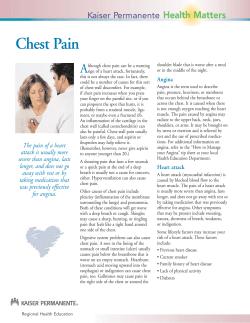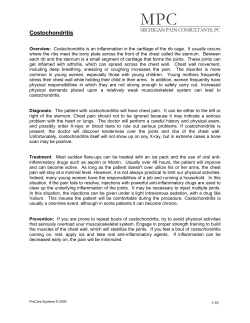
Prevalence of Chest Wall Deformities in a Large Sample of Iranian Children Aged 714 Years
Iran J Pediatr Jun 2010; Vol 20 (No 2), Pp:221-224 Short Communication Prevalence of Chest Wall Deformities in a Large Sample of Iranian Children Aged 714 Years Mohammad Taghi RajabiMashhadi1, MD; Mahmoud Ebrahimi2,3, MD; Majid Ghayour Mobarhan*, MD, MSc, PhD2,4; Mohsen Moohebati2,4, MD; Mohammad Hossein Boskabady5, MD and Seyyed Mohammad Reza KazemiBajestani2, MD D Department of Surgery, Faculty of Medicine, Mashhad University of Medical Sciences, Mashhad, IR Iran Cardiovascular Research Center, Avicenna Research Institute, MUMS, Mashhad, IR Iran Department of Cardiology, Faculty of Medicine, MUMS, Mashhad, IR Iran Department of Nutrition and Biochemistry, Faculty of Medicine, MUMS, Mashhad, IR Iran Department of Physiology, Faculty of Medicine, MUMS, Mashhad, IR Iran SI 1. 2. 3. 4. 5. Received: Apr 30, 2009; Final Revision: Jul 24, 2009; Accepted: Nov 05, 2009 of Abstract Objective: Pectus excavatum (PE) and pectus carinatum (PC) are two common chest deformities. We investigated the prevalence of chest wall deformities including PE and PC in Iranian population. ive Methods: 25587 children and adolescents aged 7‐14 years consisting of 13586 (53.1%) males and 12001 (46.9%) females were studied using cluster‐stratified sampling method. Screening was clinical and based on descriptive findings. Suspected subjects with chest wall deformity were referred to the expert surgeon to confirm the diagnosis. ch Findings: The prevalence of chest deformities in our population was 204 (1.03%). The mean age of subjects was 10.2±3.0 years. Of these subjects 124 (0.49%) [74 (54%) males and 50 (42%) females)] had PE and 80 (0.31%) [58 (72.5%) males and 22 (17.5%) females)] had PC. Ar Conclusion: The prevalence of PE seems to be very high in Iran. Special attention must be paid to diagnose and treat this problem in our population. Iranian Journal of Pediatrics, Volume 20 (Number 2), June 2010, Pages: 221224 Key Words: Pectus excavatum; Pectus carinatum; Chest wall; Deformitiy; Iran Introduction Abnormalities of the thorax often result in cosmetic complaints, but some chest wall deformities result in functional limitations such as activity intolerance related to cardiac or respiratory impairment. Reported symptoms include mild to moderate exercise limitation, respiratory infections, and asthmatic [1,2] conditions . Pectus excavatum (PE) is by far * Corresponding Author; Address: Cardiovascular Research Center, Avicenna (Bu-Ali) Research Institute, Mashhad University of Medical Sciences, Mashhad, IR Iran E-mail: ghayourm@mums.ac.ir © 2009 by Center of Excellence for Pediatrics, Children’s Medical Center, Tehran University of Medical Sciences, All rights reserved. www.SID.ir 222 Prevalence of Chest Wall Deformities in Iranian Children; MR Mashhadi, et al D of the defect and the asymmetry of the chest widely vary. Patients may present with a very mild form of PE or their sternum may be almost touching the spine. Typically, the lower third of the sternum is more involved, and the upper third may appear fairly normal. A compensatory anterior flaring of the lower ribs at each costal margin is also common. Each patient gave informed written consent to participate in the study, which was approved by the Mashhad University of Medical Sciences Ethics Committee. Findings SI the most common major congenital chest deformity, occurring in approximately 23 in every 10000 births in United States[3]. It occurs in males more frequently than in females[4]. PE with sternal depression is approximately six times more common than pectus carinatum (PC) with sternal protrusion[5]. PC consists of a spectrum of deformities, most frequently with anterior displacement of the mid and lower sternum and adjacent costal cartilages. To our knowledge, there has not been any previous report on the prevalence of chest wall deformities including PE and PC in Iran. Therefore, in the present study the prevalence of chest wall deformities was investigated in a population of about 25600 students from Mashhad, Iran. Subjects and Methods Ar ch ive of Subjects: 25587 children and adolescents consisting of 13586 (53.1%) males and 12001 (46.9%) females were studied using cluster‐ stratified sampling method during 1998 and 2001. Recruited individuals were aged 7 to 14 years and were primary or guidance school students in Mashhad, Iran. Screening Procedure: A group of especially trained general practitioners and health teachers of the schools screened all students of each cluster for chest deformity. Doubtful cases of chest deformity were examined by at least two trained general practitioners. Screening was clinical and based on descriptive findings identified in physical inspection of the chest. The hallmark of PE is the caved‐in appearance of the anterior chest. As mentioned above, the severity The prevalence of chest deformities in our population was 204 (1.03%). The mean age of subjects was 10.2±3.0 years. Of these subjects 124 (0.49%) [74 (54%) males and 50 (42%) females)] had PE and 80 (0.31%) [58 (72.5%) males and 22 (17.5%) females)] had PC. The average age of subjects with PE was 9.5±5.6 and with PC 9.9±4.6 years. Discussion The prevalence of PE in Iranian population is approximately two times higher than that in a previous report[3]. In a study of 1332 students from the northern region of Brazil (mean age 11.7 yr), the prevalence of pectus abnormalities was found to be 1.95% (PE 1.275% and PC 0.675%)[6] which is higher than that in the present study (1.03%). However, as stated in the Table 1: Prevalence of chest wall deformity in the whole population Gender Number (%) Pectus excavatum Pectus carinatum Other chest deformities Total Male 13586(53.1%) 74 (54%) 58 (72.5%) 46 (76.7%) 178(0.69%) Female 12001(46.9%) 50 (42%) 22 (17.5%) 14 (12.3%) 86 (0.34%) Total 25587(100%) 124(0.49%) 80 (0.31%) 60 (0.23%) 264(1.03%) www.SID.ir Iran J Pediatr; Vol 20 (No 2); Jun 2010 223 D Sever PE Moderate PE Mild PE Condrogladiolar PC Condromanobrial PC SI Fig. 1: Illustration of chest deformities with different severity As a limitation of the present study it is worth noting that due to the large number of study population, we did not have access to the full demographic data of participants especially their anthropometric indices. These data could have enabled us to assess the association between different biochemical and anthropometric parameters with the incidence of pectus deformities. Furthermore, it would be more helpful to determine the prevalence of cardiovascular and respiratory diseases among subjects with chest deformities as well as the impact of positive family history on the incidence of deformities. Finally, it is recommended to follow up those subjects who are candidates of surgical treatment in a future study and evaluate the impact of surgical repair on the improvement of symptoms such as respiratory problems, exercise tolerance, endurance, etc. Ar ch ive of aforementioned study, the observed prevalence was lower than previously reported figures for the southeastern (4.9%) and central‐west (3.6%) regions of Brazil[6‐8]. In regard to the general population, the prevalence of chest deformities is approximately 1%[9]. In the current study, we observed a higher prevalence of PE (54%), PC (72.5%) and overall chest deformities (67%) in males compared with the females, and thus is consistent with previous reports. As stated by Westphal and colleagues, the prevalence of chest deformities among students or preschool children from different regions of Brazil was higher in males (69.2%, 57% and 63.4% for northern, southeastern and central‐west regions of Brazil, respectively)[6]. Besides, males were also predominant among subjects from United States (78%) and Europe (76%) who were referred for the surgery of chest abnormalities[10,11]. In relation to the type of chest deformity, PE is considered to constitute more than 87% of all chest deformities[9], therefore being more frequent than PC in most of the studied populations[6,7,10‐12]. However, there are also some exceptions in which PC was found to be more common than PE such as in Argentina[9]. Moreover, PE has been reported to be very rare in African populations[9]. Conclusion In our investigation we were able to show that PE is very prevalent in Iranian population and www.SID.ir 224 Prevalence of Chest Wall Deformities in Iranian Children; MR Mashhadi, et al more attention must be paid to diagnose chest deformities in Iran. Acknowledgment This research project has been supported by the Mashhad University of Medical Sciences Research Council. The participation of the staff of the Faculty of Medicine and Ghaem Hospital of the Mashhad University of Medical Sciences is gratefully acknowledged. 5. Brodkin HA. Pigeon breast ‐ congenital chondrosternal prominence: etiology and surgical treatment by xiphosternopexy. AMA Arch Surg. 1958;77(2):261–8. 6. Westphal FL, Lima LC, Lima Neto JC, et al. Prevalence of pectus carinatum and pectus excavatum in students in the city of Manaus, Brazil. J Bras Pneumol. 2009;35(3):221‐6. 7. Haje DP, Haje SA, Simioni MA. Prevalence of pectus carinatum and pectus excavatum in students in the city of Manaus, Brazil. Brasília Med. 2002;39(1/4):10‐5. (In Portuguese) 8. Gonçalves A, Ferrari I. Characteristics of the occurrence of pectus excavatum in a study of thoracic malformation in preschool children in São Paulo. Rev Bras Ortop. 1987;22(1):19‐22. (In Portuguese) D Conflict of Interest: None 4. Shamberger RC, Welch KJ. Surgical repair of pectus excavatum. J Pediatr Surg. 1988;23(7): 615‐22. References 10. Fonkalsrud EW, Dunn JC, Atkinson JB. Repair of pectus excavatum deformities: 30 years of experience with 375 patients. Ann Surg. 2000; 231(3):443‐8. of 1. Ellis DG. Chest wall deformities. Pediatr Rev. 1989;11(5):147‐51. SI 9. Goretsky MJ, Kelly Jr. RE, Croitoru D, Nuss D. Chest wall anomalies: Pectus excavatum and pectus carinatum. Adolesc Med Clin. 2004; 15(3):455‐71. ive 2. Mavanur A, Hight DW. Pectus excavatum and carinatum: new concepts in the correction of congenital chest wall deformities in the pediatric age group. Conn Med. 2008;72(1):5‐ 11. 12. Lukanich MJ, Grodin SC. Parede do tórax e pleura. In: Townsend MC (editor). Sabiston‐ Tratado de Cirurgia. Rio de Janeiro: Guanabara Koogan. 2003; Pp:1281‐98. Ar ch 3. Chung CS, Myrianthopoulos NC. Factors affecting risks of congenital malformations. I. Analysis of epidemiologic factors in congenital malformations. Report from the Collaborative Perinatal Project. Birth Defects Orig Artic Ser. 1975;11(10):1‐22. 11. de Matos AC, Bernardo JE, Fernandes LE, Antunes MJ. Surgery of chest wall deformities. Eur J Cardiothorac Surg. 1997;12(3):345‐50. www.SID.ir
© Copyright 2025













